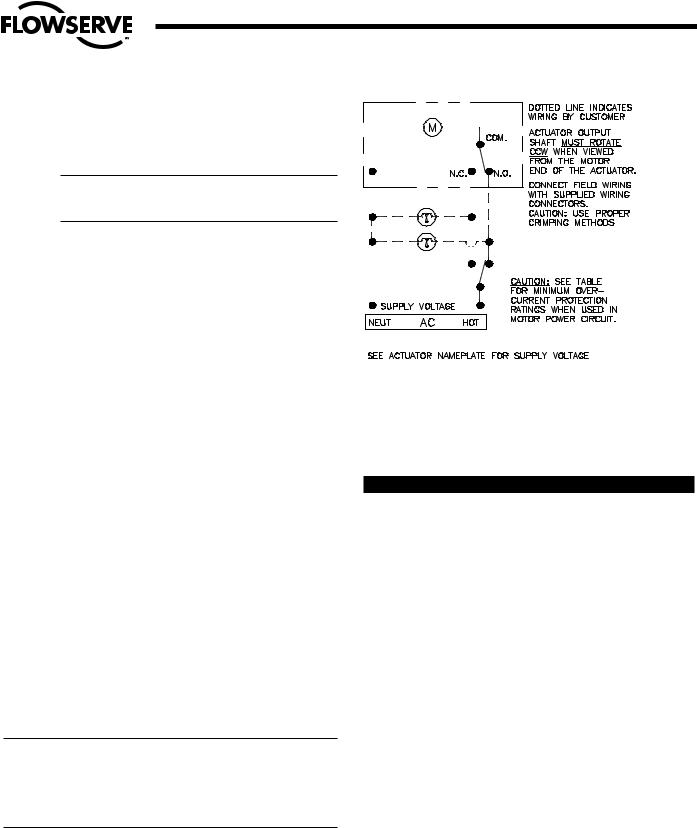Flowserve 36 User Manual

Worcester Actuation Systems
FCD WCAIM2007-00
(Part 08522)
Series 36 Electric Actuator
Installation, Operation and Maintenance Instructions
This manual includes instructions for extra limit switch and auto sequence timer options.
DESCRIPTION
Flowserve Worcester Actuation Systems Series 36 Electric Actuators are unidirectional rotary valve actuators. Standard units can provide up to 550 in-lb of torque delivered at the output shaft. The AC versions of these actuators use rugged shaded-pole motors with integral thermal overload protection and automatic reset. An internal adjustable limit switch is used for accurate control. One additional limit switch (optional) can be mounted within the unit for remote position indication or the control of an auxiliary piece of equipment.
IMPORTANT: The Series 36 Actuator is a unidirectional, 90° actuator, and therefore cannot be used on butterfly valves, ball valves with an upstream relief hole (cryogenic, chlorine, etc.), or on diverter/threeway valves (the series 75 is required for these). The actuator must be mounted above the valve, with the output shaft and valve stem vertical. It will not function if mounted at an angle, or below the valve.
a WARNING: Series 36 Actuators are electromechanical devices subject to normal wear and tear. Actuator life is dependent upon application and environmental conditions. If used in hazardous services, such as but not limited to, media temperature extremes, toxins, flammables, or other services where improper or incomplete operation could produce a safety hazard, it is incumbent upon the system designer and the user to provide proper warning devices such as temperature sensors, oxygen sensors and flow sensors. Flowserve also recommends that the optional auxiliary limit switches be used for monitoring and/or electrical interlock.
CAUTION: Flowserve recommends that all products which must be stored prior to installation be stored indoors, in an environment suitable for human occupancy. Do not store product in areas where exposure to relative humidity above 85%, acid or alkali fumes, radiation above normal background, ultraviolet light, or temperatures above 120°F or below 40°F may occur. Do not store within 50 feet of any source of ozone.
I. INSTALLATION
A.Attach mounting bracket to actuator using four (4) cap screws and lockwashers, and tighten securely. For small size top-mount style valves, attach bracket such that bracket nameplate will be to side of valve.
B.Attach actuator/bracket assembly to valve as follows:
CAUTION: Ball valves can trap pressurized media in the internal cavity. If it is necessary to remove any valve body bolts, stem nuts, or remove valve from the line, and if the valve is or has been in operation, make sure there is NO pressure to or in the valve and operate valve one full cycle.
1.Valve Models 51/52 (1/2"–2" only), 59 (2" only), 45 (21/2" only), 82/83 (1/2"–2" only) and Top Mount 44 (1/4"–2") and
59 (1/4"–11/2"):
Note: For above listed valves, it is not necessary to remove any valve body bolts or remove valve from line in order to mount actuator.
a.Close valve (valve is closed when flats on stem are perpendicular to the line of flow). If any valve information is marked on stop plate or handle, it will be necessary to transfer this information to the bracket nameplate.
b.For 1/4"–2" 44, 1/4"–11/2" 59 series top-mount style valves and 1/2"–2" 51/52, 1/2"–11/2" 82/83 series valves, with high cycle stem packing as standard, remove handle nut, lockwasher, handle, seperate stop plate (if any), retaining nut and stop pin(s). Add the two additional Belleville washers with their larger diameter sides touching each

Flow Control
Worcester Actuation Systems
other. Add the self-locking nut to the stem and tighten while holding the stem flats with a wrench. Tighten until Belleville washers are flat, the nut will “bottom”, and then back nut off 1/3 turn. The two additional Belleville washers and the self-locking nut are included in the mounting kit.
CAUTION: The self-locking stem nut is difficult to tighten, and must fully flatten the Belleville washers before backing off.
For 2" 59, 21/2" 45, and 2" 82/83 valves only, remove handle assembly, retaining nut, stop and stop screws. Replace with valve stem spacer, or with two Belleville washers (if valve has graphite stem packing), and replace retaining nut. NOTE: Belleville washers are installed with larger diameters touching each other. Using a wrench to prevent stem from turning, tighten retaining nut until stem packing is fully compressed or Bellevilles, if used, are fully flattened, then back off nut 1/6 turn. Excessive tightening causes higher torque and shorter seal life. NOTE: Valves with V51 high cycle stem packing option installed, identified by two Belleville washers installed and handle assembly, stop and stop screws removed, do not require stem area disassembly.
c.Center coupling on valve stem.
d.Lower actuator/mounting bracket assembly over coupling and onto valve, making sure that the slot in the actuator shaft will engage male tang on coupling.
e.Secure bracket to valve using cap screws and lockwashers provided in mounting kit. Tighten securely. For small size top-mount style valves, the bracket nameplate will be to the side of the valve.
II.ELECTRICAL INSTALLATION AND ADJUSTMENT
(Refer to Figures 1 and 2)
Make conduit connection to NPT fitting on actuator base (1/2" NPT for 10-2036).
CAUTION: In cases where the conduit connected to the actuator may be partially or completely run underground, or through which moisture may contact energized live parts, or where the actuator and/or conduit is exposed to temperature differences, the conduit should be sealed within 18" of the actuator in accordance with the National Electrical Code.
A.Wiring Termination
The 36 Actuator wiring is done using the wire terminations provided. One “wire nut” is used to connect the actuator’s “free” motor lead to incoming power. Two other incoming leads are connected at the actuator limit switch by 3/16" “quick-connect” crimp-type wiring connectors. These wiring connectors are fitted to the NO (normally open) and NC (normally closed) terminals of the actuator limit switch.
Figure 1
1
The actuator should be electrically grounded in accordance with standard procedures.
See table for minimum fuse rating when overcurrent protection is used in motor power circuit. NOTE: The table shows the minimum rating to prevent inrush current from blowing the fuse.
TABLE 1: MINIMUM FUSE RATING FOR OVERCURRENT PROTECTION
Actuator Size |
AC Voltage |
Fuse Rating (A) |
10 |
120 |
3 |
|
|
|
20 |
120 |
5 |
|
|
|
10 |
240 |
1.5 |
|
|
|
20 |
240 |
3 |
|
|
|
B.Actuator Rotation
Incoming power is alternately applied between the NO or NC switch terminals and the “free” motor lead. When the proper voltage is applied to the actuator its output shaft and bull gear turn counterclockwise (CCW) when viewed from above.
C.Proper 90° Operation
The 36 Actuator is a unidirectional actuator which is designed to stop at each 90° position of one complete rotation. This interval is determined by the detents on the face of the actuator’s output gear. The arm of a limit switch rides over these detents controlling the point at which actuator motion will stop.
Mounting the actuator to the valve such that the actuator’s conduit entry is in line with the piping will allow the following operation:
Switch Arm Position* |
Valve Position |
Up |
Open |
|
|
Down |
Closed |
*The switch arm has just hit the transition point on the gear face detent.
Rotating the entire actuator on the valve 90° (and rotating the ball 90°) so that the conduit opening is cross-line to the piping will

Flow Control
Worcester Actuation Systems
Figure 2
change the above details. When the switch arm is up, the valve is closed; when the switch arm is down, the valve is open.
D.Proper Alignment of Switch:
The limit switch is adjusted and set at the factory for proper 90° operation. Verify switch setting prior to operation. In the event that the switch is not at the desired setting, adjust as follows:
The limit switch of the 36 Actuator can be adjusted in two directions; up-and-down and side-to-side (refer to Fig. 2).
To adjust the limit switch, loosen the adjusting screws on the casting’s switch support. Once these screws are loosened, the limit switch can move up, down and sideways a total of 3/8 inches.
Moving the switch horizontally causes both stop points to shift. Moving the switch vertically changes the 90°/90° rotation.
Adjust the switch vertically for uniform 90° cycles, then shift it horizontally to set the stop points.
Secure the switch fastening screws when proper valve indexing is verified thru one complete rotation of the valve (360°).
The actuator is now ready for operation.
Motor Module:
AC Motors: If the motor winding is short-circuited, or if the thermostat has opened the winding, the unit will not operate. If the motor is hot, allow it to cool down so that the stator is at room temperature. Apply voltage to motor. If motor still fails to operate, replace the entire motor module.
Motor Bearing Alignment: The actuator motor uses self-aligning bearings. During shipment, the bearing may become misaligned, so the actuator will not operate. Tapping the motor stator (lamination around top bearing bracket with a plastic hammer or screwdriver handle) while it is energized will realign the bearings. The unit will then develop full output. To perform this adjustment, reenergize unit with cover off. If rotor hums, but does not turn, tap stator lightly as described.
Valve: The problem may lie with the valve instead of with the actuator. Check the operation of the valve by removing the actuator and operating the valve manually. Measure valve torque and compare to actuator torque.
Optional Switch: If an extra switch is used, its contact arm must lead (be shorter than) the contact arm of the actuator operating switch, i.e., the auxilliary switch must trip before the positioning switch.
Check to ensure clearance between the extra limit switch lever arm and the retaining shroud. If they are touching, loosen the motor mounting screws and move retaining shroud enough to clear the switch lever arm.
IV. SPARE PARTS
The following are recommended spare parts which should be kept on hand for Series 36 Electric Actuators:
1 Spare Limit Switch (Used for Valve Control Only)
NOTE: This spare limit switch can be ordered by part number and differs from the (optional) extra limit switch.
When ordering any spare parts, please specify actuator size and voltage.
III. MAINTENANCE and
TROUBLESHOOTING
a WARNING: Disconnect power during cover removal.
The Series 36 Electric Actuator requires no regular maintenance. The actuator utilizes a permanently lubricated gear train. No additional lubrication is necessary.
Should the actuator fail to operate, the following are hints for troubleshooting.
Electrical Supply: Be sure the actuator is supplied with the correct voltage.
Electrical Connections: Does the wiring conform to the wiring diagram?
V. ELECTRICAL REQUIREMENTS
The following table represents current draw in amperes at the various voltages and rated stall torque for each motor:
Voltage (AC) |
1036 (5 sec.) |
2036 (5 sec.) |
|
120 |
2.3 |
3.8 |
|
|
|
|
|
240 |
1.0 |
1.7 |
|
|
|
|
|
The duty cycle for all motors used in the Series 36 Actuator is 20% (at 70°F).
